英文埃及介绍
- 格式:ppt
- 大小:1.84 MB
- 文档页数:19
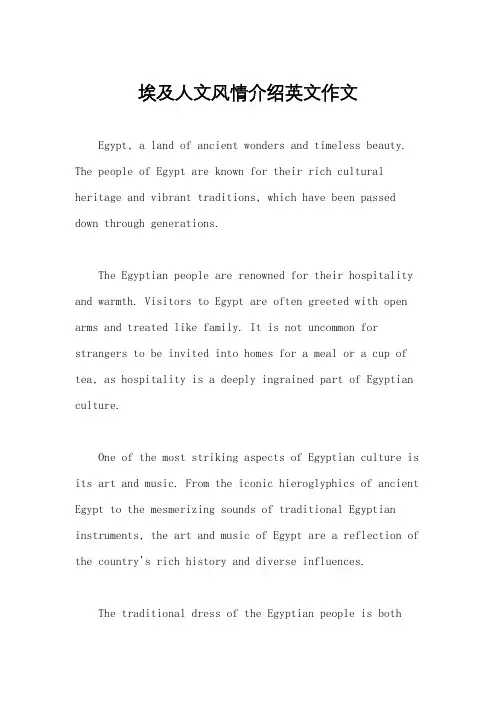
埃及人文风情介绍英文作文Egypt, a land of ancient wonders and timeless beauty. The people of Egypt are known for their rich cultural heritage and vibrant traditions, which have been passed down through generations.The Egyptian people are renowned for their hospitality and warmth. Visitors to Egypt are often greeted with open arms and treated like family. It is not uncommon for strangers to be invited into homes for a meal or a cup of tea, as hospitality is a deeply ingrained part of Egyptian culture.One of the most striking aspects of Egyptian culture is its art and music. From the iconic hieroglyphics of ancient Egypt to the mesmerizing sounds of traditional Egyptian instruments, the art and music of Egypt are a reflection of the country's rich history and diverse influences.The traditional dress of the Egyptian people is bothpractical and elegant. Men often wear the galabeya, aloose-fitting robe that is well-suited to the country's hot climate, while women may be seen in colorful, flowing dresses and headscarves.Egyptian cuisine is a feast for the senses, with an array of flavors and spices that reflect the country's diverse influences. From the hearty, savory dishes of Upper Egypt to the fragrant, delicately spiced cuisine of the Nile Delta, Egyptian food is a celebration of the country's rich agricultural heritage.The ancient monuments of Egypt, such as the pyramids of Giza and the temples of Luxor, are a testament to the ingenuity and skill of the Egyptian people. These iconic structures continue to inspire awe and wonder, drawing visitors from around the world to marvel at their timeless beauty.The Egyptian people are known for their strong sense of community and family. Family ties are deeply cherished, and gatherings with extended family are a common occurrence.The bonds of family and community are a source of strength and support for the Egyptian people, providing a sense of belonging and connection in a rapidly changing world.。
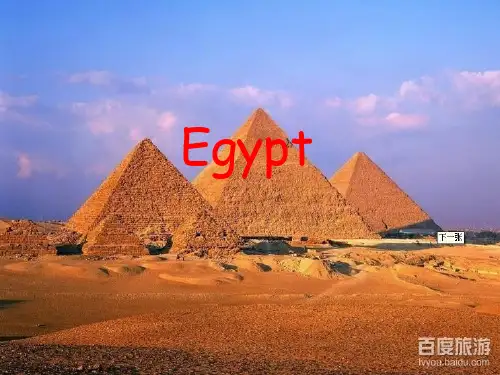

Pyramids and pharaohs, mummies and magic, picture writing on papyrus—ancient Egypt had all this, and much more. Rich, powerful, and peace-loving, this North African kingdom was home to a splendid civilization that lasted 3,000 years, from about 3300 BC to 30 BC.RED LAND, BLACK LANDAncient Egypt was a vast territory, stretching 700 miles (1,100 kilometers) southward from the Mediterranean Sea. Most of it was hot, dry, and dusty. The Egyptians called it Deshret(red land). But the world’s longest river, the Nile, runs through this desert. Every year, the river flooded the surrounding land. The floods left sticky, smelly mud covering the land along the riverbanks. Egyptians called the riverside area Kemet (black land). This land was very fertile. About 5000 BC, the ancient Egyptians built some of the world’s first farms and villages there.THE GIFT OF THE NILEEgypt was sometimes called “the gift of the Nile.” All Egyptian life depended on the river. Farmers dug ditches to bring its water to fields of wheat, grapes, and onions. Rich nobles, town traders, and poor country families all built homes made of sun-dried river mud. Craftspeople shaped clay from the Nile into pottery, and wove cloth from the flax plant that grew on its banks. Families caught fish and river birds for food. Children played in riverside pools, but they had to watch out for killer crocodiles!LIFE IN ANCIENT EGYPTMost ancient Egyptian homes had just two or three rooms, with workspace on the roof. Rich people built larger houses, with painted walls, fine furniture, gardens, and pools. In poor families, women wore rough homemade dresses and men wore cloths tied around the hips. But the rich could afford curled wigs, makeup, colored clothes, and jewels. They had servants and slaves to work for them.Rich or poor, all Egyptians valued family life. They married young and had many children. Families worked together and played together. Egyptian people liked games, stories, music, dancing, and holiday feasts and parades.The ancient Egyptians believed in magic and many gods. People built little shrines to their favorite gods. They wore amulets (charms), and recited prayers and spells. They also built statues representing gods. The most famous is the Great Sphinx of Giza. This huge statue with the body of a lion and the head of a man still stands today.HIEROGLYPHS AND PAPYRUSThe ancient Egyptians had a complex system of writing known as hieroglyphics. This form of writing looks like columns of little pictures. These picture-symbols are called hieroglyphs. Not everyone could read hieroglyphs. Reading and writing was the job of special scholars called scribes.Scribes wrote in hieroglyphs on papyrus, a kind of paper made from reeds. This was some of the world’s first writing! Pages of poems, songs, st ories, math, science, and astronomy have all been preserved.POWERFUL PHARAOHSEgyptian kings were known as pharaohs. Egyptians said the pharaohs were the children of a god. They were links between heaven and Earth. Pharaohs were the chief priests, lawmakers, and army commanders of the kingdom. They gave orders to governors, judges, tax collectors, and soldiers. They made treaties with foreign rulers and controlled trade with other countries. All Egyptians had to pay taxes to them or work on their building projects.PYRAMID TOMBS AND MUMMIESSome of the pharaohs had great pyramids constructed. A pyramid was an enormous stone tomb. Building a pyramid was a tremendous project. Thousands of people worked for many years to construct one. Some of the stone blocks that make up the pyramids weigh more than two elephants!The ancient Egyptians believed that their bodies must survive for life after death. They had their bodies made into mummies. Mummies were preserved, dried, and wrapped in cloth. Egyptians hoped this would help their spirits survive after they died. Pharaoh mummies were placed in pyramids or great tombs surrounded by treasures to be used in the afterlife. Guides to the world of the dead written in hieroglyphs on papyrus have been found with mummies. Most royal mummies, and the treasures buried with them, were stolen by grave robbers long ago.LASTING REMINDERS OF THE PASTEgypt’s rich civilization attracted many invaders. But it survived for thousands of years. In 30 BC, Egypt’s last pharaoh—Queen Cleopatra—killed herself rather than surrender to Roman conquerors. That was 2,000 years ago. But ancient Egypt has not been forgotten. Some mummies were so well preserved that they are still around. Some of them are inmuseums. And many of ancient Egypt’s gr eatest monuments, including many pyramids, are still standing. You can visit them!。
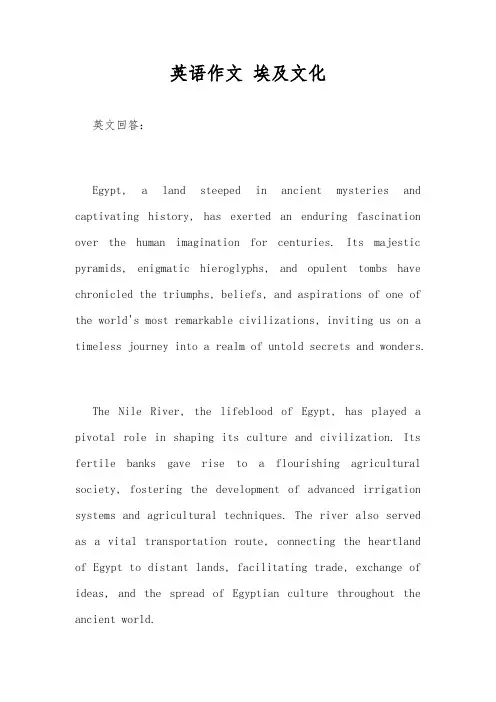
英语作文埃及文化英文回答:Egypt, a land steeped in ancient mysteries and captivating history, has exerted an enduring fascination over the human imagination for centuries. Its majestic pyramids, enigmatic hieroglyphs, and opulent tombs have chronicled the triumphs, beliefs, and aspirations of one of the world's most remarkable civilizations, inviting us on a timeless journey into a realm of untold secrets and wonders.The Nile River, the lifeblood of Egypt, has played a pivotal role in shaping its culture and civilization. Its fertile banks gave rise to a flourishing agricultural society, fostering the development of advanced irrigation systems and agricultural techniques. The river also served as a vital transportation route, connecting the heartland of Egypt to distant lands, facilitating trade, exchange of ideas, and the spread of Egyptian culture throughout the ancient world.Religion played a central role in ancient Egyptian society, shaping its social, political, and economic structures. The Egyptians believed in a complex pantheon of gods and goddesses who governed the forces of nature and human affairs. Elaborate temples and rituals were erected to honor and appease these deities, and the pharaohs, considered divine intermediaries, held both temporal and spiritual power.Egyptian art, with its distinctive style and iconography, offers a glimpse into the society's beliefs, values, and aesthetic sensibilities. The colossal statues, elaborate reliefs, and vibrant paintings that adorn the walls of temples and tombs depict scenes from daily life, religious ceremonies, and historical events. These artistic creations served not only as aesthetic expressions but also as a means of preserving the past and offering prayers to the gods.The ancient Egyptians were renowned for theiradvancements in science and technology. Their knowledge of astronomy, mathematics, and medicine was far ahead of their time. They developed a sophisticated calendar system, studied the stars to predict celestial events, and practiced advanced surgical techniques. Their architectural prowess is evident in the construction of the pyramids, massive structures that stand as testament to their engineering genius.Egypt's cultural heritage continues to inspire and captivate the world today. Its ancient temples, tombs, and artifacts attract millions of visitors each year, eager to witness the splendor of a civilization that has left an indelible mark on human history. The legacy of Egypt's pharaohs, gods, and scribes lives on, offering us valuable insights into the human condition and the enduring power of the human spirit.中文回答:埃及,这片古老神秘和引人入胜的历史之地,几个世纪以来一直吸引着人类的想象力。

英文介绍埃及作文Egypt is a fascinating country in North Africa with a rich history and culture. It is home to the famous pyramids, the Sphinx, and the Nile River, which is the longest riverin the world.The ancient Egyptians were skilled builders and architects, as evidenced by the impressive pyramids and temples that still stand today. These structures are a testament to the ingenuity and advanced knowledge of the ancient Egyptians.Egyptian cuisine is known for its delicious andflavorful dishes, such as koshari, ful medames, and mahshi. The use of spices and herbs, such as cumin, coriander, and mint, adds depth and complexity to the flavors of Egyptian food.The Egyptian people are known for their hospitality and warmth. Visitors to Egypt are often welcomed with open armsand are treated to delicious food and lively conversations. The sense of community and togetherness is an important part of Egyptian culture.The bustling markets of Egypt are a feast for the senses, with vibrant colors, exotic scents, and the lively sounds of bargaining and haggling. The markets are filled with a wide variety of goods, from spices and textiles to handmade crafts and souvenirs.The ancient art and hieroglyphics of Egypt provide a glimpse into the beliefs and practices of the ancient Egyptians. The intricate carvings and paintings on the walls of temples and tombs tell stories of gods, pharaohs, and everyday life in ancient Egypt.The music and dance of Egypt are lively and expressive, often accompanied by traditional instruments such as the oud, tabla, and qanun. The rhythmic beats and graceful movements of Egyptian dance are a reflection of thecountry's rich cultural heritage.The natural beauty of Egypt is also a major draw for visitors, with its stunning deserts, crystal-clear waters, and diverse wildlife. The Red Sea is a popular destination for diving and snorkeling, offering a chance to explore the colorful coral reefs and marine life.Overall, Egypt is a country that offers a unique blend of history, culture, and natural beauty. It is a place where ancient traditions and modern life coexist, creating a truly unforgettable experience for those who visit.。
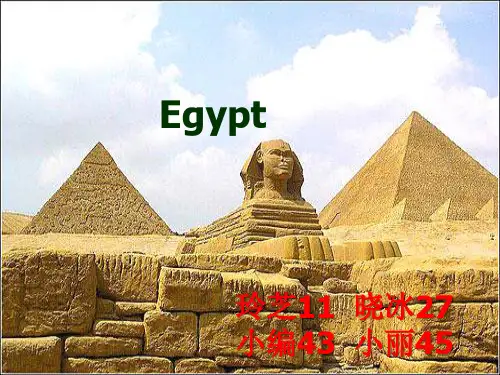

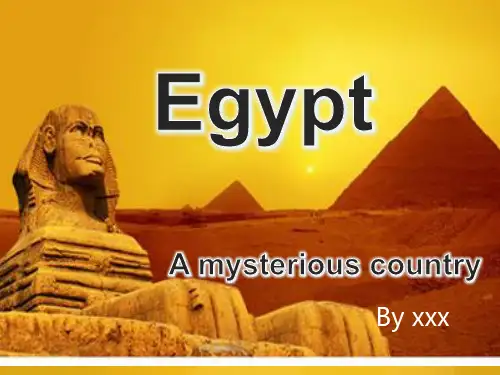
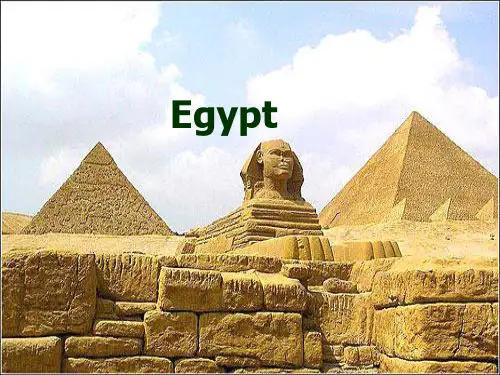
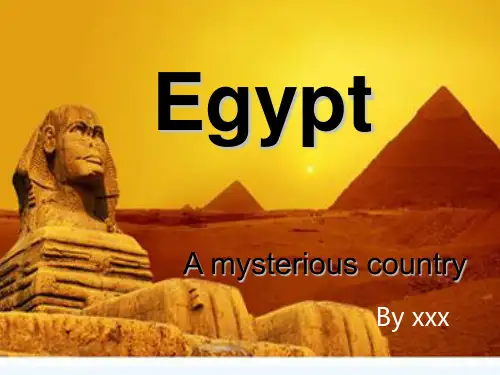
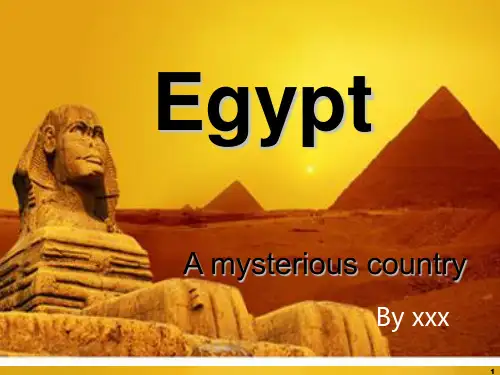
埃及介绍英文版Egypt, officially the Arab Republic of Egypt, is a country mainly in North Africa, with the Sinai Peninsula forming a land bridge in Western Asia. Covering an area of about 1,010,000 square kilometers (390,000 sq mi), Egypt is bordered by the Mediterranean Sea to the north, the Gaza Strip and Israel to the northeast, the Red Sea to the east, Sudan to the south and Libya to the west.Egypt is one of the most populous countries in Africa and the Middle East. The great majority of its estimated 77.4 million[1] live near the banks of the Nile River, in an area of about 40,000 square kilometers (15,000 sq mi), where the only arable agricultural land is found. The large areas of the Sahara Desert are sparsely inhabited. About half of Egypt's residents live in urban areas, with the majority spread across the densely-populated centres of greater Cairo, Alexandria and other major cities in the Nile Delta.Egypt is famous for its ancient civilization and some of the world's most famous monuments, including the Giza pyramid complex and its Great Sphinx. The southern city of Luxor contains numerous ancient artifacts, such as the Karnak Temple and the Valley of the Kings. Egypt is widely regarded as an important political and cultural nation of the Middle East.Egypt possesses one of the most developed economies in the Middle East, with sectors such as tourism, agriculture, industry and service at almost equal rates in national production.[citation needed] Consequently, the Egyptian economy is rapidly developing, due in part to legislation aimed at luring investments, coupled with both internal and political stability, along with recent trade and market liberalization.埃及,全称阿拉伯埃及共和国,是东北非洲人口最多的国家,面积为1,020,000平方公里,人口已超过8000万。
埃及人文地理简介英文Egypt: An Introduction to Its Cultural and Geographical LandmarksIntroductionSituated in North Africa, Egypt is a country renowned for its rich cultural heritage and diverse geography. From ancient archaeological sites to vibrant cities, Egypt offers a captivating blend of history, beauty, and intrigue. In this article, we will delve into the country's cultural and geographical highlights, exploring the wonders that make Egypt a truly unique destination.1. Historical SignificanceEgypt's historical significance cannot be overstated. As one of theworld's oldest civilizations, it boasts a legacy that dates back thousands of years. Ancient Egypt was characterized by the construction of iconic monuments, such as the Great Pyramids of Giza, the Sphinx, and the temples of Luxor and Karnak. These marvels continue to amaze visitors and serve as a testament to the civilization's architectural prowess.2. Nile River and DeltaThe Nile River, the longest in the world, is a lifeline for Egypt's agriculture and transportation. Spanning approximately 6,650 kilometers, it flows through the country, providing fertile soil for agriculture and sustaining diverse ecosystems. The Nile Delta, where the river meets the Mediterranean Sea, is a region of great ecological importance and is home to numerous species of marine life.3. Deserts and OasesEgypt's landscape is dominated by vast deserts, such as the Sahara and the Arabian Desert. These arid regions are renowned for their unique beauty, with towering sand dunes and mesmerizing rock formations. Within these deserts lie hidden oases, small pockets of greenery surrounded by the barren landscape. The Siwa Oasis and the Bahariya Oasis are among the most famous, offering tranquil retreats amidst the harsh desert environment.4. The Red Sea RivieraAlong Egypt's eastern coastline lies the Red Sea Riviera, a haven for beach enthusiasts and water sports enthusiasts. This picturesque region is home to stunning coral reefs, teeming with vibrant marine life, making it a paradise for snorkelers and divers. Popular resorts such as Sharm El Sheikh and Hurghada offer a perfect blend of luxurious comfort and natural wonders, attracting visitors from around the world.5. Islamic Cairo and Coptic CairoIn the heart of Egypt's capital, Cairo, lies a treasure trove of historical and cultural sites. Islamic Cairo, with its mosques and medieval architecture, takes visitors back in time to the days of the Fatimid Caliphate. The Al-Azhar Mosque and the Saladin Citadel are notable landmarks within this district. Coptic Cairo, on the other hand, is a hub of Christian heritage, housing ancient churches and synagogues. The Hanging Church and the Coptic Museum are popular attractions in this area.6. Luxor and AswanLuxor and Aswan, located along the Nile River, are cities steeped in ancient history. Luxor is home to the famous Valley of the Kings, where pharaohs were laid to rest, as well as the magnificent temple complexes of Karnak and Luxor. Aswan, known for its picturesque setting, is famous for the UNESCO-listed Abu Simbel temples and the Philae temple complex, which was relocated to escape the rising waters of the Nile due to the construction of the Aswan High Dam.ConclusionEgypt's cultural and geographical landmarks offer an unparalleled experience for travelers seeking to immerse themselves in a world of wonder. From the grandeur of ancient Egypt's monuments to the abundant marine life in the Red Sea, Egypt has something to captivate and inspire every visitor. Explore the country's rich history, embrace the beauty of its natural landscapes, and create memories that will last a lifetime in this captivating land of ancient wonders.。
想了解埃及历史英文作文英文:Egypt is a country with a long and rich history. From the ancient civilization of the Pharaohs to the modern-day Egypt, this country has gone through many changes and developments.One of the most fascinating periods in Egypt's history is the time of the Pharaohs. They ruled over Egypt for thousands of years and left behind a legacy that still captivates people today. The Pyramids of Giza, the Sphinx, and the Valley of the Kings are just a few of the many monuments that they left behind.During the time of the Pharaohs, Egypt was also known for its advanced technology and innovations. They were skilled in agriculture, architecture, and engineering. One of the most impressive feats of engineering was the construction of the Pyramids. It is still a mystery howthey were able to build these massive structures with such precision and accuracy.In addition to their technological advancements, the Pharaohs were also known for their art and culture. They created beautiful works of art, such as paintings, sculptures, and jewelry. They also had a complex religion and belief system that included many gods and goddesses.Moving forward in time, Egypt has also played a significant role in world history. It was a major center of trade and commerce in the ancient world, and it was also a key player in the development of early Christianity and Islam.Today, Egypt is a modern and thriving country with a rich cultural heritage. It is home to many museums and historical sites that showcase its fascinating history.中文:埃及是一个历史悠久而丰富的国家。
埃及遗迹英文介绍作文英文:Egypt is a country rich in history and culture, and its ancient ruins and artifacts are a testament to its fascinating past. As someone who has always been interested in history, I have had the opportunity to visit some of Egypt's most famous archaeological sites.One of the most impressive sites I visited was the Great Pyramids of Giza. These towering structures, built over 4,500 years ago, are a marvel of engineering and a testament to the ingenuity of the ancient Egyptians. Standing at the base of the pyramids and looking up attheir massive size is truly awe-inspiring.Another site that I found particularly interesting was the Valley of the Kings. This is where many of the pharaohs of the New Kingdom era were buried, including the famous Tutankhamun. The tombs are filled with intricatehieroglyphics and elaborate paintings, and it's amazing to think that these decorations have survived for thousands of years.In addition to these famous sites, I also had the chance to visit some lesser-known ruins, such as the Temple of Karnak and the Temple of Luxor. These temples are filled with stunning columns, statues, and reliefs, and it's clear that the ancient Egyptians put a great deal of effort into their construction.Overall, visiting Egypt's ancient ruins was an incredible experience that allowed me to learn more about this fascinating country and its rich history.中文:埃及是一个历史悠久、文化丰富的国家,其古代遗迹和文物是其迷人过去的见证。